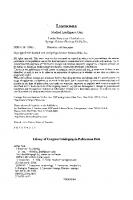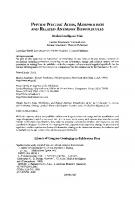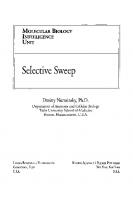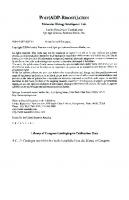Lysosomes (Medical Intelligence Unit) 0387255621, 9780387255620
Lysosomes are membrane-surrounded organelles which are present in all animal cells. The importance of this organelle is
129 18 15MB
English Pages 209 [208] Year 2005
Recommend Papers

- Author / Uploaded
- Paul Saftig (editor)
File loading please wait...
Citation preview
MEDICAL INTELUGENCE UNIT
Lysosomes Paul Saftig, Ph.D. Biochemisches Institut Christian-Albrechts-Universitat Kiel Kiel, Germany
L A N D E S B I O S C I E N C E / EUREKAH.COM
GEORGETOWN, TEXAS
U.SA
SPRINGER SCIENCE+BUSINESS M E D I A
NEW YORK, NEW YORK
USA
LYSOSOMES Medical Intelligence Unit Landes Bioscience / Eurekah.com Springer Science+Business Media, Inc. ISBN: 0-387-25562-1
Printed on acid-free paper.
Copyright ©2005 Eurekah.com and Springer Science+Business Media, Inc. All rights reserved. This work may not be translated or copied in whole or in part without the written permission of the publisher, except for brief excerpts in connection with reviews or scholarly analysis. Use in connection with any form of information storage and retrieval, electronic adaptation, computer software, or by similar or dissimilar methodology now known or hereafter developed is forbidden. T h e use in the publication of trade names, trademarks, service marks and similar terms even if they are not identified as such, is not to be taken as an expression of opinion as to whether or not they are subject to proprietary rights. While the authors, editors and publisher believe that drug selection and dosage and the specifications and usage of equipment and devices, as set forth in this book, are in accord with current recommendations and practice at the time of publication, they make no warranty, expressed or implied, with respect to material described in this book. In view of the ongoing research, equipment development, changes in governmental regulations and the rapid accumulation of information relating to the biomedical sciences, the reader is urged to carefully review and evaluate the information provided herein. Springer Science+Business Media, Inc., 233 Spring Street, New York, New York 10013, U.S.A. http://www.springeronline.com Please address all inquiries to the Publishers: Landes Bioscience / Eurekah.com, 810 South Church Street, Georgetown, Texas 78626, U.S.A. Phone: 512/ 863 7762; FAX: 512/ 863 0081 http://www.eurekah.com http://www.landesbioscience.com Printed in the United States of America. 9 8 7 6 5 4 3 2 1
Library of Congress Cataloging-in-Publication Data Saftig, Paul. Lysosomes / Paul Saftig. p. ; cm. ~ (Medical intelligence unit) Includes bibliographical references and index. ISBN 0-387-25562-1 (alk. paper) 1. Lysosomes. I. Title. II. Series: Medical inteUigence unit (Unnumbered : 2003) [DNLM: 1. Lysosomes—enzymology. 2. Lysosomes—metabolism. 3. Biological Transport. 4. Lysosomal Storage Diseases—therapy. Q U 350 S128L 2005] QH603.L9S24 2005 571.6'55~dc22
2005013404
Dedicated to Jane and Lynn ... and all patients suffering of diseases with an impaired lysosomal function.
CONTENTS Preface 1. History and Morphology of the Lysosome Renate Lullmann-Rauch Morphology of Lysosomes History of the Lysosome Concept 2. Transport of Lysosomal Enzymes Stephan Storch and Thomas Braulke Synthesis and Modifications of Soluble Lysosomal Proteins Formation of Mannose 6-Phosphate Recognition Marker Mannose 6-Phosphate Receptors Signal Structure-Dependent Trafficking of MPRs Sorting Functions of Mannose 6-Phosphate Receptors Delivery to the Endosomal/Lysosomal Compartment Mannose 6-Phosphate Receptor-Independent Pathways Perspectives
xi 1 2 11 17 17 18 19 20 21 21 21 22
3. Adaptor Proteins in Lysosomal Biogenesis Peter Schu Heterotetrameric Adaptor-Protein Complexes Membrane Binding of Adaptor-Proteins Adaptor-Protein Sorting Pathways Coadaptor Proteins
27
4. Lysosomal Membrane Proteins
37
27 29 30 32
Paul Saftig LAMPs and LIMPs as Major Components of the Lysosomal Membrane LAMP-Deficient Mice Intracellular Trafficking of the Major Lysosomal Membrane Glycoproteins Less Abundant Integral Components of the Lysosomal Membrane Perspectives 5. Lysosomal Proteases: Revival of the Sleeping Beauty Klaudia Brix Expression and Distribution of Lysosomal Proteases Importance of the in Situ Determination of Proteolytic Activities Functions of Lysosomal Proteases
39 40 42 43 46 50 51 52 53
6. Lysosomal Storage Disorders Ole Kristian Greiner-Tollersrudand Thomas Berg The Lysosomal Storage Disorders Defects in Glycan Degradation Defects in Glycoprotein Degradation (Glycoproteinoses) Defects in Glycolipid Degradation Degradation of G^i Ganglioside Degradation of Sulfatide Degradation of Globotriaosylceramide Defects in Glycosaminoglycan Degradation (Mucopolysaccharidoses) Defects in Glycogen Degradation Defects in Lipid Degradation Defects in Protein Degradation Defects in Lysosomal Transporters Defects in Trafficking 7. Lysosomal Transporters and Associated Diseases Frans W. Verheijen and Grazia M.S. Mancini The Lysosomal Membrane and Storage Diseases Cystinosin, CTNS2Lnd Cystinosis... Sialin, 5ZC77^5 and Sialic Acid Storage Disease CLN3 and Batten Disease (Juvenile Ceroid Lipofuscinosis) NPCl and Niemann-Pick Disease SLC36A1 Encoding LYAAT-1, a Transporter for Small Neutral Amino Acids MCOLNl, Mucolipin and Mucolipidosis Type IV TCIRG-1 and CICN7, A3 Subunit ATPase and Chloride Channel 7, Lysosomal Acidification Disorder, Infantile Malignant Osteopetrosis (Albers-Schonberg Disease) 8. Neuronal Ceroid-Lipofuscinoses Jaana Tyyneld Classification and Genetics Clinical Characteristics Neuronal Degeneration Neuronal Storage Material Palmitoyl-Protein Thioesterase 1 (PPTl) Tripeptidyl Peptidase I (TPPI) Cathepsin D CLN3 Protein CLN5, CLN6 and CLN8 Proteins Animal Models Pathogenetic Considerations
60 62 62 62 GA GG GG GG GG 68 68 68 69 69 74 74 7G 77 78 78 79 79
79 82 82 84 84 86 86 88 89 90 90 91 93
9. Cholesterol Transport in Lysosomes Judith Storch and Sunita R. Cheruku Intracellular Cholesterol Transport Endogenously Synthesized Cholesterol Transport Exogenously Derived Cholesterol Transport Mechanism of Cholesterol Transport from Lysosomes Lysosomal Cholesterol Transport Candidates: Niemann-Pick C Disease NPCl NPC2
100 100 101 102 104 104 105 106
10. Therapy of Lysosomal Storage Diseases Ulrich Matzner Lysosomal Storage Diseases Enzyme Replacement Therapy Transplantation Therapy In Vivo Gene Therapy Enzyme Enhancement Therapy Substrate Reduction Therapy
112
11. Lysosomal Proteome and Transcriptome Johst Landgrehe and Torhen Lubke Analysis of Lysosomal Structure and Function Using Proteomics and Transcriptomics Proteome Analysis of Lysosomal Proteins Transcriptome Analysis of Lysosome Functions
130
12. External Lysosomes: The Osteoclast and Its Unique Capacities to Degrade Mineralised Tissues Vincent Everts and Wouter Beertsen The Osteoclast as a Highly Polarized Proton-Secreting Cell
112 116 117 120 122 123
130 130 137
144 144
13. Membrane Resealing Mediated by Lysosomal Exocytosis Norma W. Andrews "Secretory" Lysosomes Ca^'^-Regulated Secretion of Conventional Lysosomes Regulation of Lysosomal Exocytosis by Synaptotagmin VII
156
14. Macroautophagy in Mammalian Cells Eeva-Liisa Eskelinen Macroautophagic Pathway Induction and Regulation of Macroautophagy Functions of Autophagy Autophagy Genes Quantitation of Autophagy Guidelines for Identification of Autophagic Vacuoles in Transmission Electron Microscopy Future of Autophagy
166
156 158 158
166 171 172 173 175 177 177
15. Chaperone-Mediated Autophagy Erwin Knecht and Natalia Salvador Distinctive Characteristics of Chaperone-Mediated Autophagy Lysosomes Can Take Up Selectively Ribonuclease A and Other Proteins from Cytosol An Amino Acid Sequence of Ribonuclease A Is Essential for Its Selective Lysosomal Targeting The Selective Lysosomal Pathway for the Degradation of Proteins Containing KFERQ-Like Sequences Is Active in Various Cell Types under Certain Conditions Molecular Chaperones Participate in the Selective Lysosomal Transport of Proteins LAMP2a Is a Receptor Protein in the Lysosomal Membrane for the Entry of Proteins from the Cytosol into Lysosomes by Chaperone-Mediated Autophagy Index
181 184 185 185
187 187
189 195
11
rriTT'^^o HiLJl
—'
Paul Saftig Biochemisches Institut Christian-Albrechts-Universitat Kiel Kiel, Germany Chapter 4
r^r^XTXPTPTinrr^pc VvvJlM 1 rv Norma W. Andrews Section of Microbial Pathogenesis and Department of Cell Biology Boyer Center for Molecular Medicine Yale University School of Medicine New Haven, Connecticut, U.S.A. Chapter 13 Wouter Beertsen Department of Experimental Periodontology Academic Centre of Dentistry Amsterdam (ACTA) Universiteit van Amsterdam Amsterdam, The Netherlands Chapter 12 Thomas Berg Department of Medical Biochemistry Institute of Medical Biology University of Tromso Tromso, Norway Chapter 6 Thomas Braulke Department of Biochemistry UKE, Children's Hospital University of Hamburg Hamburg, Germany Chapter 2 Klaudia Brix School of Engineering and Science International University Bremen Bremen, Germany Chapter 5
Sunita R. Cheruku Department of Nutritional Sciences Rutgers University New Brunswick, New Jersey, U.S.A. Chapter 9 Eeva-Liisa Eskelinen Institute of Biochemistry Christian-Albrechts-University of Kiel Kiel, Germany Chapter 14 Vincent Everts Department of Oral Cell Biology Academic Centre of Dentistry Amsterdam (ACTA) Vrije Universiteit Amsterdam, The Netherlands Chapter 12 Ole Kristian Greiner-ToUersrud Department of Medical Biochemistry Institute of Medical Biology University of Tromso Tromso, Norway Chapter 6 Erwin Knecht Fundacion Valenciana de Investigaciones Biomedicas Instituto de Investigaciones Citologicas Valencia, Spain Chapter 15
11 11 11
Jobst Landgrebe DNA Microarray Facility University of Gottingen Gottingen, Germany Chapter 11 Torben Lubke Institute of Biochemistry 2 University of Gottingen Gottingen, Germany Chapter 11 Renate Lullmann-Rauch Department of Anatomy Christian-Albrechts-University of IGel Kiel, Germany Chapter 1 Grazia M.S. Mancini Department of Clinical Genetics Erasmus Medical Center Rotterdam, The Netherlands Chapter 7 Ulrich Matzner Institute for Physiological Chemistry University of Bonn Bonn, Germany Chapter 10 Natalia Salvador Fundaci6n Valenciana de Investigaciones Biom^dicas Instituto de Investigaciones Citologicas Valencia, Spain Chapter 15
Peter Schu Center for Biochemistry and Molecular Cell Biology Biochemistry II Georg-August University Gottingen Gottingen, Germany Chapter 3 Judith Storch Department of Nutritional Sciences Rutgers University New Brunswick, New Jersey, U.S.A. Chapter 9 Stephan Storch Department of Biochemistry UKE, Children's Hospital University of Hamburg Hamburg, Germany Chapter 2 Jaana Tyynela Institute of Biomedicine/Biochemistry Neuroscience Research Program University of Helsinki Helsinki, Finland Chapter 8 Frans W. Verheijen Department of Clinical Genetics Erasmus Medical Center Rotterdam, The Netherlands Chapter 7
^PREFACE
--
The lysosome is the cell's main digestive compartment into which many types of macro molecules are delivered for degradation. However, during the last ten years it has become evident that lysosomes have more complex functions than simply being the "waste basket" of the cell. Lysosomes can be involved in various cellular processes such as cholesterol homeostasis (Chapter 9), autophagy (Chapters 14 and 15), repair of the plasma membrane (Chapter 13), bone remodelling (Chapter 12), defence against pathogens, cell death, and signaling. More than 50 acid hydrolases have been identified which are involved in the ordered lysosomal degradation of a variety of proteins, lipids, carbohydrates, and nucleic acids (Chapters 5, 6 and 11). These hydrolases are enclosed by a limiting membrane containing a set of highly glycosylated lysosomal membrane proteins (Chapter 4). Lysosomal enzymes are also components of cell type-specific compartments referred to as lysosomerelated organelles and include melanosomes, lytic granules, M H C class II compartments, platelet-dense granules, and synaptic-like microvesicles. Functional deficiencies of several lysosomal proteins give rise to the lysosomal storage diseases (Chapters 6, 7, 8 and 10). The biogenesis of new lysosomes or lysosome-related organelles requires a continuous delivery of newly synthesized components. The targeting of acid hydrolases depends on the presence of mannose-6-phosphate residues that in turn are recognized by specific receptors, mediating the intracellular transport to an endosomal/prelysosomal compartment (Chapters 2 and 3). The more I work with the lysosomal compartment the more I realize that lysosomes are not simply a dead end in the endocytotic pathway. The majority of physiological processes involve at least a transient encounter with this cellular compartment. A more detailed understanding of the fiinctions of lysosomes will shed light on the molecular basis of pathological conditions in which the degradation and transport processes of intracellular molecules are aifected. This is reflected by the exponentially increasing volume of literature dealing with the biology of the lysosome. This book will only be able to pinpoint some of the essentials of what has been published recently. The goal of this book is to introduce the major features of lysosomes at a level which should be useful for both interested students as well as researchers and clinicians in need of a broad background. When I was asked to edit a book aiming to provide information about lysosomal functions, I was fascinated by the chance to meet and talk with some of the leading experts in the field, but also a little apprehensive about whether I would be able to cover both the novel findings and the more established lysosomal research. I am now glad that I had this opportunity to interact closely with many colleagues who have been extremely generous with their time and efforts. I am especially happy that this book has turned out to be a blend of contributions from young colleagues who are pushing
the lysosome community forward with new concepts and ideas as well as contributions from more experienced and well recognized experts in various aspects of lysosomal function. Once again, I would like to express my gratitude to all contributors and to the editor who helped me to realize this project. Last but not least I would like to thank Kurt von Figura, my teacher and mentor in "lysosomal matters", for his continuous support and interest in my research. Without his advice I would have missed many interesting aspects of this intriguing organelle.
Paul Safiig
CHAPTER 1
History and Morphology of the Lysosome Renate Lullmann-Rauch* Abstract
T
he lysosome is the cellos main digestive compartment to which all sorts of macromolecules are delivered for degradation. The structure of the lysosome is variable and depends on the cell type and the actual conditions. In terms of function and cytochemistry, the lysosome is identified by the following criteria: acid pH, hydrolases with acid pH optimum, specific highly glycosylated membrane-associated proteins, and the absence of the mannose-6-phosphate receptor. The purposes of the present chapter are (a) to give a short overview on the morphology of the lysosome/endosome system for readers who are nonexperts in this field; and (b) to briefly trail the tracks and approaches which, during the first decades after the discovery of the lysosome, led to the present concept, with particular reference to morphology.
Introduction Lysosomes are membrane-delimited organelles which occur in all mammalian cells except red blood cells. Lysosomes are defined by functional rather than structural properties. They contain a high proton concentration (pH < 5) and more than 40 hydrolases with a pH optimum below 6. Their limiting membrane is endowed with specific integral proteins including a vacuolar-type H^-ATPase, several highly glycosylated proteins and various types of transporters as reviewed in Chapters 4, 7, and 9 of this volume. Lysosomes are engaged in the degradation of macromolecules delivered from the celFs own cytoplasm (autophagy. Chapters 14 and 15 of this volume) as well as materials taken up from the extracellular space (endocytosis). Depending on the cell type and the functional state, lysosomes can considerably vary in structure. Therefore it is not surprising that the existence of lysosomes was first realized solely on the basis of biochemical results. The term lysosome ^2& coined by DeDuve five decades ago.^ Only thereafter, ultrastructural and enzyme-cytochemical studies of Novikoff and coworkers^'^ uncovered the morphologic identity of lysosomes. Expanding research in this field gradually revealed the lysosomes as being part of the highly dynamic endosome/lysosome system (Fig. 1), a collection of several categories of vesicular organelles which to a certain extent exchange membrane constituents and contents thus having overlapping properties. An important feature of lysosomes which serves to discriminate them from endosomes and other related vesicles is the absence of mannose-6-phosphate receptors. Since the history of a scientific concept is appreciated particularly in the light of the present state of knowledge, the first part of this article briefly summarizes the basics of what is known today about the morphology of lysosomes including the morphological correlates of lysosome biogenesis. The second part provides a short historical review of the development of the lysosome concept during the first two to three decades following its original formulation. *Renate Lijllmann-Rauch—Department of Anatomy, University of Kiel, Olshausenstrafee 40, 24098 Kiel, Germany. Email: [email protected]
LysosomeSy edited by Paul Saftig. ©2005 Eurekah.com and Springer Science+Business Media.
Lysosomes
^
enzyme recapture
enzyme # secretion
MPR-
Y pi' membr. receptorandligand
Igp/iamp-f-f-fpH :0bb"^C z
=
CN CN CM D"
^ ^cn
. ^
u
z
CD
ri ^ o
—I .rj
°Z_co
O e CN : S CD rn
UJ Z
03
U _1
. E
c
1
-
t/5
13
.9 c I
O
o
LU
>
i^
O
^S LO > CN
m
CN
CD
^
C/^-D 0
I
Dvjf^:
LZO > S I 3 0 >
^ u I iC "3 I
•EO
ii
U
t*i
.^ ^ ^^
O
O) " - r e C2
is 1^^i t ^ i :§i ^
'E
l ^ Q_ ojLiJ
=;
c
u
z u _ J
u
z u
z u
00
z 1
u
z u u
Q)
c O U
O



![Cell Adhesion Molecules in Human Transplantation (Medical Intelligence Unit) [2nd ed.]
1570595178, 9781570595172, 9780585408569](https://ebin.pub/img/200x200/cell-adhesion-molecules-in-human-transplantation-medical-intelligence-unit-2ndnbsped-1570595178-9781570595172-9780585408569.jpg)


![Hematopoietic Stem Cell Development (Medical Intelligence Unit) [1 ed.]
0306478722, 9780306478727](https://ebin.pub/img/200x200/hematopoietic-stem-cell-development-medical-intelligence-unit-1nbsped-0306478722-9780306478727.jpg)


